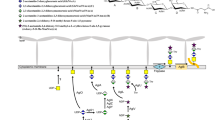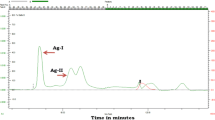Abstract
Enterobacter hafniae and Aeromonas hydrophila ADPglucose synthetases were purified approximately 39-and 61-fold, respectively, over the crude extract. Both enzymes were heat stable at 60°C in the presence of inorganic phosphate. The molecular weights of both enzymes were approximately 200,000 which are similar to other enteric ADPglucose synthetases studied. Based on kinetic results obtained from the partially purified enzymes, the E. hafniae enzyme is activated twofold by phospho-enolpyruvate while the A. hydrophila enzyme is activated twofold by fructose 6-P and 1.5-fold by fructose 1,6 bis-phosphate. The E. hafniae enzyme activity is strongly inhibited by AMP and ADP and the inhibition can be partially reversed by P-enolpyruvate. ADP is the most effective inhibitor of the A. hydrophila enzyme and its inhibiton can be partially overcome by the presence of the activators fructose 6-P and fructose 1,6-P2. These kinetic results show that the allosteric properties of the E. hafniae enzyme are distinctly different from the ADPglucose synthetases of those previously studied from bacteria of the genus Enterobacter. Although the A. hydrophila enzyme is activated by fructose 1,6-P2, its allosteric properties are quite different than those observed for ADPglucose synthetase of the Enterobacteriaceae.
Similar content being viewed by others
Abbreviations
- Hepes:
-
N-2-hydroxyethylpiperazine-N′-2-ethane-sulfonic acid
- glucose 1-P:
-
α glucose 1-phosphate
- Bicine:
-
N,N-bis(2 hydroxyethyl)glycine
- fructose 6-P:
-
fructose 6-phosphate
- Mes:
-
2(N-morpholino)-ethane sulfonic acid
- fructose 1,6-P2 :
-
fructose 1,6 bis-phosphate
- DTE:
-
dithioerythritol; pyridoxal-P, pyridoxal-phosphate
- fructose 1-P:
-
fructose 1-phosphate
- P-enolpyruvate:
-
phospho-enolpyruvate
- 1,6 hexanediol bis-P:
-
1,6 hexanediol bis-phosphate; glucose 6-P, glucose 6-phosphate
- dihydroxyacetone-P:
-
dihydroxyacetone phosphate
- 1-glycerol-3-P:
-
1-glycerol-3-phosphate
- erythrose 4-P:
-
erythrose 4-phosphate
- 2-P-glycerate:
-
2-phosphoglycerate
- sedoheptulose 1,7-P2 :
-
sedoheptulose 1,7 bis-phosphate
- 3-P-glycerate:
-
3-phosphoglycerate
- mannose-6-P:
-
mannose-6-phosphate
References
Bascomb S, Lapage SP, Willcox WR (1971) Numerical classification of the tribe Klebsielleae. J Gen Microbiol 66:279–295
Boyer C, Preiss J (1977) Biosynthesis of bacterial glycogen. Purification and properties of Escherichia coli B α-1,4-glucan:α-1,4-glucan 6-glycosyltransferase. Biochemistry 16:3693–3696
Buchner T, Pfleiderer G (1955) Pyruvate kinase from muscle. In: Colowick SP, Kaplan NO (eds) Methods in enzymology, vol 1. Academic Press, Inc, New York, pp 435–440
Changeux JP (1963) Allosteric interactions on biosynthetic l-threonine deaminase from E. coli K-12. Cold Spring Harbor Symp Quant Biol 28:497–504
Cohen GN, Stanier RY, Le Bras G (1969) Regulation of the biosynthesis of amino acids of the aspartate family in coliform bacteria and pseudomonads. J Bacteriol 99:791–801
Crawford IP (1954) A new fermentative Pseudomonad, Pseudomonas formicans, n. sp. J Bacteriol 68:734–738
Crawford IP, Sikes S, Melhorn DK (1967) The natural relationships of Aeromonas formicans. Arch Mikrobiol 59:72–81
Fox GE, Stackebrandt E, Hespell RB, Gibson J, Maniloff J, Dyer TA, Wolfe RS, Balch WE, Tanner RS, Magrum LJ, Zablen LB, Blakemore R, Gupta R, Bonen L, Lewis BJ, Stahl DA, Luehrsen KR, Chen KN, Woese CR (1980) The phylogeny of prokaryotes. Science 209:457–463
Fox J, Kawaguchi K, Greenberg E, Preiss J (1976) Biosynthesis of bacterial glycogen. Purification and properties of the Escherichia coli B ADP glucose: 1.4-α-d-glucan 4α glucosyltransferase. Biochemistry 15:849–857
Gosh HP, Preiss J (1966) Adenosine diphosphate glucose pyrophosphorylase. A regulatory enzyme in the biosynthesis of starch in spinach leaf chloroplasts. J Biol Chem 241:4491–4504
Govons S, Genter N, Greenberg E, Preiss J (1973) Biosynthesis of bacterial glycogen. XI. Kinetic characterization of an altered adenosine diphosphate glucose synthase from a glycogen-excess mutant of Escherichia coli B. J Biol Chem 248:1731–1740
Greenberg E, Preiss J (1964) The occurrence of adenosine diphosphate glucose: glycogen transglucosylase in bacteria. J Biol Chem 239:4314–4315
Greenberg E, Preiss JE, Boldrick M van, Preiss J (1983) Biosynthesis of bacterial glycogen: Activator specificity of the ADPglucose pyrophosphorylase of Rhodopseudomonas. Arch Biochem Biophys 220:594–604
Jensen RA, Stenmark SL (1970) Comparative allostery of 3-deoxy-d-arabinoheptulosonate-7-phosphate synthetase as a molecular basis for classification. J Bacteriol 101:763–769
Kelmers AD, Hancher CW, Phares ER, Novelli GD (1971) Largescale fermentation of Escherichia coli and recovery of transfer ribonucleic acids. In: Moldave K, Grossman L (eds) Methods in enzymology, vol 20. Academic Press, Inc, New York, pp 3–4
Kornberg A (1955) Lactic dehydrogenase of muscle. In: Colowick SP Kaplan NO (eds) Methods in enzymology, vol 1. Academic Press, Inc, New York, pp 441–443
Koshland DE Jr, Nemethy G, Filmer D (1966) Comparison of experimental binding data and theoretical models in proteins containing subunits. Biochemistry 5:365–385
Largen M, Belser WL (1975) Tryptophan biosynthetic pathway in the Enterobacteriaceae: some physical properties of the enzymes. J Bacteriol 121:239–249
Lehmann M, Preiss J (1980) Biosynthesis of bacterial glycogen: purification and properties of Salmonella typhimurium LT-2 adenosine diphosphate glucose pyrophosphorylase. J Bacteriol 143:120–127
Levitzki A, Koshland DE Jr (1969) Negative cooperativity in regulatory enzymes. Proc Natl Acad Sci 62:1121–1128
Lowry OH, Rosebrough NJ, Farr AL, Randall RJ (1951) Protein measurement with the Folin phenol reagent. J Biol Chem 193:265–275
Martin RG, Ames BN (1961) A method for determining the sedimentation behavior of enzymes: application to protein mixtures. J Biol Chem 236:1372–1379
Preiss J (1978) Regulation of adenosine diphosphate glucose pyrophosphorylase. In: Meister A (ed) Advances in enzymology and related areas of molecular biology, vol 46. John Wiley and Sons, Inc, New York, pp 317–381
Preiss J, Walsh DA (1981) The comparative biochemistry of glycogen and starch. In: Ginsberg V, Robbins P (eds) Biology of carbohydrates, vol 1. John Wiley and Sons, Inc. New York, pp 199–314
Preiss J, Crawford K, Downey J, Lammel C, Greenberg E (1976) Kinetic properties of Serratia marcescens adenosine 5′-diphosphate glucose pyrophosphorylase. J Bacteriol 127:193–203
Ribéreau-Gayon G, Sabraw A, Lammel C, Preiss J (1971) Biosynthesis of bacterial glycogen. IX. Regulatory properties of the adenosine diphosphate glucose pyrophosphorylase of the Enterobacteriaceae. Arch Biochem Biophys 142:675–692
Rohlfing SR, Crawford IP (1966) Purification and characterization of the β-galactosidase of Aeromonas formicans. J Bacteriol 91:1085–1097
Shen L-C, Atkinson DE (1970) Regulation of adenosine diphosphate glucose synthase from Escherichia coli. Interactions of adenylate energy charge and modified concentrations. J Biol Chem 245:3996–4000
Shen L, Preiss J (1964) The activation and inhibition of bacterial adenosine diphosphorylase. Biochem Biophys Res Commun 17:424–429
Stanier RY, Adams GA (1944) The nature of the Aeromonas fermentation. Biochem J 38:168–171
Steigerwalt AG, Fanning GR, Fife-Asbury MA, Brenner DJ (1976) DNA relatedness among species of Enterobacter and Serratia. Can J Microbiol 22:121–137
Steiner KE, Preiss J (1977) Biosynthesis of bacterial glycogen: genetic and allosteric regulation of glycogen biosynthesis in Salmonella typhimurium. J Bacteriol 129:246–253
Taketa K, Pogell BM (1965) Allosteric inhibition of rat liver fructose 1,6-diphosphate by adenosine-5′-monophosphate. J Biol Chem 240:651–662
Author information
Authors and Affiliations
Rights and permissions
About this article
Cite this article
Yung, SG., Paule, M., Beggs, R. et al. Biosynthesis of bacterial glycogen: characterization of adenosine diphosphate glucose synthetases from Enterobacter hafniae and Aeromonas hydrophila . Arch. Microbiol. 138, 1–8 (1984). https://doi.org/10.1007/BF00425398
Received:
Accepted:
Issue Date:
DOI: https://doi.org/10.1007/BF00425398




